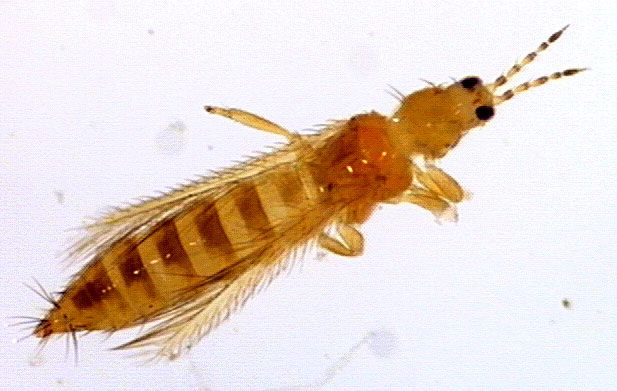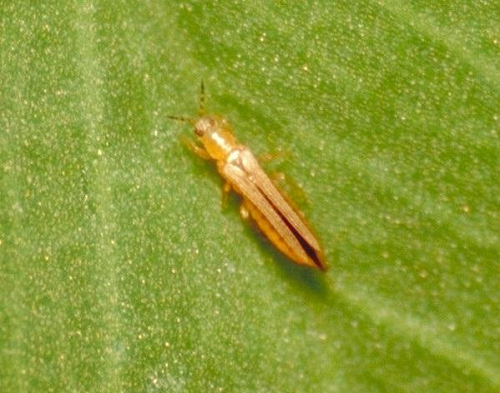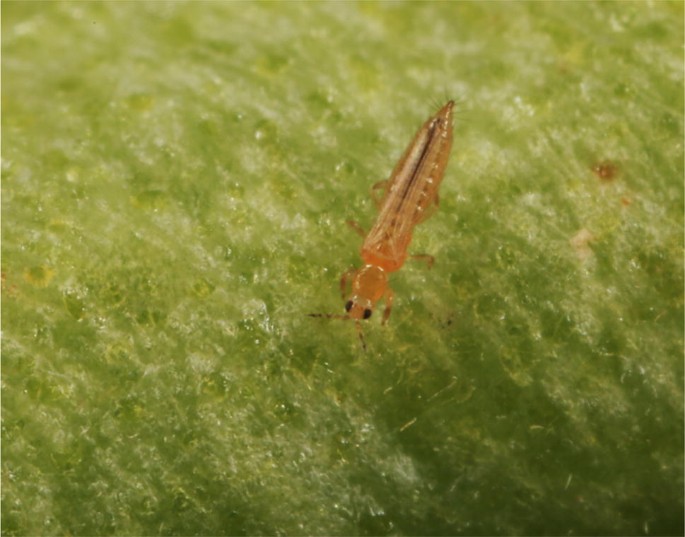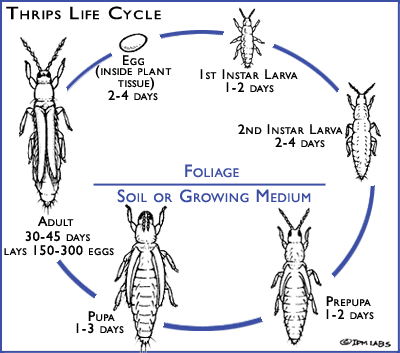thrips life cycle pdf
EggÆ2 Nymphs feed on plantÆ2 quiescent Nymphs ÆWinged Adult. From spring to fall which usually numbers 8 months over a dozen generations might appear every year.

Biology And Management Of Thrips Affecting The Production Nursery And Landscape Uga Cooperative Extension
Life cycle Thrips Fig.

. The life cycle of thrips consists of the egg stage followed by two larval stages two pupal stages and finally the adult stage Figure 1. Variations in the length of each life stage occur between thrips species but in general. At 25C it takes 13 days.
Typically hundreds of thrips infest each flower and their feeding and egg laying punctures result in a brown discoloration of the white petals. Onion thrips feed by puncturing the epidermis with a stout mandible puncturing deeper mesophyll cells with a fine pair of stylets maxillae and sucking out the cell contents. For most thrips species the duration is two weeks.
Ultimately after the next molt a winged adult form emerges to repeat the cycle. Eggs inserted into the plant tissue by the females sharp egg-laying tube ovipositor hatch in about 6 days. Thrips Habitat Thrips can be found in all regions of North America.
Two larval stages require about 6 days for completion. Among the most common and damaging species of pest thrips are Thrips tabaci onion thrips and Frankliniella occidentalis Western flower thrips. The rate of development strongly depends on temperature.
There are two larval stages which together last from 8 to more than 20 days. The chilli thrips adults life span lasts 158 days on Figure 4. Then the prepupal and pupal stages take an additional 4 days and generally occur in the soil.
For example at 28C it takes 110 days for a first instar larva to progress to the adult stage on pepper plants and 133 days on squash plants. Life Cycle In the thrips life cycle egg-to-adult development takes about 16 days. Thrips live on plants.
The entirely life cycle of onion thrips can be completed in about three or four weeks during the summer and multiple generations occur on onions. As such the only way to effectively deal with western flower thrips in greenhouse production systems is by using a. 2 lifecycle diagram.
Look for them in. Life Cycle Reproduction Thrips have an unusual life cycle that starts with hatching from an egg and then going through two feeding larval stages followed by two non-feeding stages called the. Eggs inserted into the plant tissue by the females sharp egg-laying tube ovipositor hatch in about 6 days.
After four to five days larvae hatch to feed on leaves and flowers. Larvae emerge and begin to feed on the plant. Haemorrhoidalis completes its entire life cycle within the tree canopy either between touching fruit or between.
General thrips life cycleAdult female thrips use their sharp ovipositor to insert eggs into the tissue of the cotton plant. The life cycle consists of five stages. Under controlled conditions on chili pepper Caspicum annuumL in greenhouses the life cycle is completed in 1314 days Hutasoit et al.
Eggs hatch within 3 to 20 days. IV with the thrips in the same site that also is non-feeding stage which further transitions its development. Reproductive capacity rapid life cycle egg to adult small size approximately 20 mm long unusual feeding habits preference for secluded habitats unexpanded leaves and unopened flower buds and resistance to insecticides.
At 20C development from egg to adult takes approximately 19 days. Western Flower Thrips Life Cycle Egg Nymphs n 2 Pupae n 2 Adult Lifecycle may be completed in 18 to 24 days depending on temperature Why Western Flower Thrips Are A Major Insect Pest Of Greenhouse-Grown Horticultural Crops High reproductive capacity Broad host range Rapid life cycle Resistance to insecticides Virus. Eggs are often laid into plant tissue stems leaves flowers or fruit but some species lay.
The egg will normally hatch within a couple of days after being laid and the stage that follows Instar I is tiny and wingless. Some thrips are considered pests. Female adult western flower thrips live up to 30 days and lay 2-10 eggs per day.
Thrips pass through six developmental stages. Females deposit eggs directly in the host tissue. Eggs once lain incubate for 2 to 16 days.
Egg larval prepupal pupal and adult. They suck the sap out of the leaves and the affected areas often appear to be shimmering because air enters into the empty cells. In the thrips life cycle egg-to-adult develop - ment takes about 16 days.
Two larval stages require about 6 days for completion. Together all stages from nymph to adult require at least 7 days and at most 15. Two larval stages require about 6 days for completion.
Thrips species are capable of causing rind blemish injury from onset of clustered fruit contact beginning in early May until har-vest. Adults as well as first and second instar larvae are feeding stages. Thrips are members of the insect Order Thysanoptera.
Females lay their eggs singly. It feeds on the leaves and within a few days will molt to a larger second stage Instar II that feeds more extensively on the plant. Regarding the life cycle of these thrips eggs are inserted into plant tissues.
Thrips florum Schumtz is a common pest of gardenia Gardenia jasminoides Ellis flowers in Hawaii. The life cycle and biology of this pest was studied on gardenia flowers to facilitate. Eggs are inserted into leaves.
Then the prepupal and pupal stages take an additional 4 days. The thrip eggs are laid within the plant tissue with a saw-like ovipositor. After two molts the larva enters the pre-pupal stage lasts about 1 day during which wing buds are developing externally.
Thrips live about 45 days and those that are born late in summer will go into diapause until the spring so the species can continue to thrive in the following spring. The eggs of most plant-feeding thrips are. Most species insert eggs into plant tissue.
The time required to complete a single life cycle of both onion thrips and western flower thrips is dependent on temperature. The thrips then enters the nonfeeding prepupal stage. When the weather is warm the life cycle from egg to adult may be completed in as short a time as 2 weeks.
Life Cycle In the thrips life cycle egg-to-adult development takes about 16 days. Thrips are mostly troublesome in August. Males are generally smaller than the females.
Larvae go through two molts in four to five days mature and pupate. Then the prepupal and pupal stages take an additional 4 days. Thrips have several generations up to about eight a year.
They hatch into the first nymph. Thrips display parthenogenesis reproducing without mating and both mated and unmated females can lay eggs. Generation time varies with temperature and the species but generally takes about a month.
DAMAGE Thrips feeding on plants can damage fruit leaves and shoots and. The average life span of a mated female is. The life cycle of thrips includes an egg two larval stages that actively feed followed by two or three non-feeding pupal stages Fig.
The eggs are inserted into soft plant tissues including flowers leaves stems and fruit. An egg two larval stages a prepupal and pupal stage and an adult. Eggs inserted into the plant tissue by the females sharp egg-laying tube ovipositor hatch in about 6 days.
The life span of chilli thrips is influenced by the host plant species.

Onion Thrips Wisconsin Vegetable Entomology

High Tunnel Management Thrips Usu

Optimization Of Dietary Rna Interference Delivery To Western Flower Thrips Frankliniella Occidentalis And Onion Thrips Thrips Tabaci Andongma 2020 Archives Of Insect Biochemistry And Physiology Wiley Online Library
Thrips In Greenhouse Crops Biology Damage And Management

The Life Cycle Of Thrips Youtube

How To Get Rid Of Thrips On Houseplants Houseplants Garden Pests Garden Pest Control

Thrips Onion And Garlic Agriculture Pest Management Guidelines Uc Statewide Ipm Program Uc Ipm
Thrips In Greenhouse Crops Biology Damage And Management

Onion And Western Flower Thrips Entomology

Onion And Western Flower Thrips Entomology

Special Issue On Novel Management Tactics For The Western Flower Thrips Springerlink

Critters Down Under Thrips Pro Mix Greenhouse Growing
Thrips In Greenhouse Crops Biology Damage And Management





